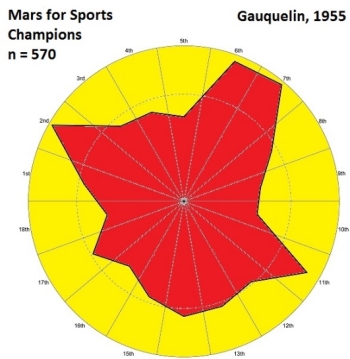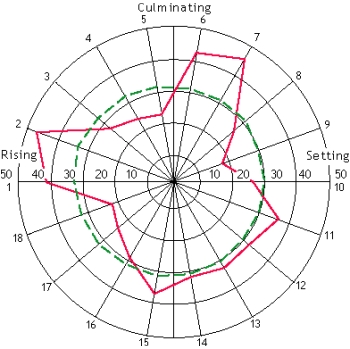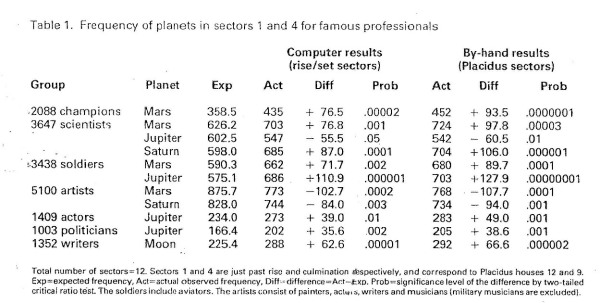Re-evaluating the Gauquelin Data
PAGES
- Introduction
- Expected and Observed planetary frequencies in the Gauquelin professional groups
- The Ertel Enigma
- Report by the French Skeptics, 1982-96
- The Work of Arno Müller
- From the Archives
- Synastry Effects in the Gauquelin 'Heredity' Data
- Poets and the Moon
- Character traits
- Venus
- Database of Character-Traits
- Introvert-Extravert
- Physicians and Sports Champion Data
- Where's the Data?
- Was It Significant?
- A Fourfold Effect
- The Shape of the Gauquelin Professional-Data Effect
- Astro-Psychological Problems
- Françoise and Michel, a Productive Partnership
13. Physicians and Sports Champion Data
French Physicians
The first group of professional data that Michel Gauquelin gathered, was that of 576 French members of the prestigious Académie de Médecine. See discussion on Page 5. It is here reconstructed by using the data(Excel spreadsheet) given in his first book L'Influence des Astres.
The larger group of 1083 (see Page 5) members of the Académie de Médecine as published by Arno Müller and Suitbert Ertel11 contained all but 18 of this group, and the CURA group of physicians contained all of them2.
His original data showed a very strong Saturn excess, plus a marked Mars excess, and a Jupiter-deficit:
| MG 1955 data (n=576), % excess in two Key Sectors, and Chi-Square values. | ||||
|---|---|---|---|---|
| Planet | Expect | Obs. | % Excess | Chi-Square |
| SA | 96 | 130 | +35 | 12 |
| MA | 101 | 123 | +22 | 5 |
| JU | 96 | 81 | -16 | |
Using a modern program (Jigsaw), our results on the same data are:
| Planet | Expect | Obs. | % Excess | Chi-Square |
| SA | 96 | 122 | +27 | 7 |
| MA | 101 | 118 | +17 | 3 |
| JU | 96 | 85 | -11 |
The planetary effects thus appear as having been considerably exaggerated.
The Gauquelins published their final total of physicians in 1970, the same as is now up on the CURA site. Comparing that with what is nowadays obtained by using that CURA data one sees how the original error in physicians score went uncorrected into its total:
| Physicians (n=2552) Key Sector scores published 1972 vs CURA 2018 | |||||
|---|---|---|---|---|---|
| Planet | Expect | 1970 | KS Excess | CURA | KS Excess |
| SAT | 425 | 503 | +18% | 486 | +14% |
| MARS | 447 | 527 | +18% | 509 | +13% |
| JUP | 425 | 394 | -7% | 396 | -7% |
Yes these errors are large, but the Gauquelins were doing all the computations by hand.
Sports-Champions
His first book L'Influence des Astres (1955) had MG's results for Mars and 570 French sports champions. That data-set has here been re-created in digital form(Excel spreadsheet), for the first time3. His book used an 18-fold division of the circle and we here do the same. My reconstruction of his result bears a resemblance - but, it's not the same:


Comparing his result using the same data and scoring the two Key Sectors (1 and 4):
| No. of Sports Champions | KS Score | Expected Score | % Excess | Chi-Square | Probability | |
| MG 1955 | 570 | 68+68 | 97.8 | 39% | 32 | 1 in 70,0004 |
| NK 2018 | 570 | 59+67 | 99.85 | 26% | 7 | 1 in 20 |
Again we see the massive exaggeration of a planetary effect, which he never as such corrected. And these are his best-known results!
That error was imported into the 1972 data-volume, when 2088 sports champions' birthdata were published by the two Gauquelins: a much too high score of Mars-in-key sectors was reported6.
When in 1980 the Gauquelins went to the Astro-Computing Services in California, the data was all recalibrated by computer and the exaggerated Mars-sports champion was there corrected: it turned out to be too high by 17 points, out of 2088 total - as reported by MG in his 1984 Correlation article, 'Profession and Heredity Experiments, computer re-analysis.' MG there explained that the new results
'were somewhat lower in significance due to inadvertent bias in the hand calculations when interpolating from tables'7.
We're prepared to accept that, but there is a problem in the way he continues to use the old by-hand values, rather than the new, correct ones - because the old ones looked better, perhaps?

Here is the Table from his 1984 article in which he cites the correct values ('computer results'), I believe no book he published subsequently used these, or apologised for the earlier to-high values. Au contraire, he went on using them.
In 1982 the statistician Good summarised the Gauquelin thesis as:
The basic observation of Gauquelin was that of 2,088 European sports champions, of whom 452 were born when Mars was in Gauquelin's sectors 1 or 4...8
In a 1988 article, one of the last MG wrote, he is still quoting the erroneous 452 total for the 2088 sports champions9 - and claiming it gave a chi-square value of '26.2'! That would correspond to the astronomically high significance level, which he was not shy of claiming.
In a thirty-page article entitled 'Is there a Mars Effect?' by the man who discovered it, one might expect use of the corrected computer-ascertained values that he was shown in 1980, after he had gone all the way to California to get it. Instead, he preferred his own hand-calculated data published in 1970-72. In the same year 1988 a laudatory volume appeared reviewing Gauquelin's life-work with a foreword by Professor Eysenck, and it re-published his 1955 data, uncorrected.
The whole 20th century debate on the subject seems to have proceeded without anyone taking note of the corrected data! Proper values, as ascertained by the Californian computer of ACS (Astro-Computing Services) in San Diego, were reported only in the above one table in the journal Correlation in 1984, but no book by the Gauquelins or anyone else ever reported on it or discussed it. Over the twelve years of its existence, Françoise Gauquelin's journal APP never reported on how the huge errors both for physicians and sports champions, had greatly inflated the significance.
We presumably accept Ertel's view that the errors were caused by 'bias' not cheating as such.
Nowadays one can readily check the values as given by the online CURA data, which is identical with that published in 1970-72. That gives total key-sector scores of 435 not 452 for Mars in the 2088 sports champions, and 486 not 503 for Saturn and 2552 Physicians. Was not the whole 20th-century debate on the subject invalidated by errors of such magnitude?
Note on Expected Frequencies:
MG was prone to citing unduly high significance levels. The above Table cites a 0.000002 probability value for his corrected Mars-sports champion data, that's one in half a million. It used a too-low expected frequency: we've seen how the most reliable expected-frequency values were those generated by Mark Pottenger (see page 2) and they show that the 'Mars-dawn' effect gives an extra 5% expected for the Key Sectors above the general one-sixth of total, thus the expected value for Mars should be 365 not 358. That would still give a high significance level, of about 1 in 2000. As regards why all these significance computations are fairly meaningless, see Page 15.
A correspondence between the German psychologists Arno Müller and Suitbert Ertel (at the universities of Saarlandes and Gottingen) took place in the journal Zeitschrift for Parapsychologie (seven articles by Müller and ten by Ertel), which might well throw light upon matters discussed here. Ertel was inclined to attribute 'bias' but not fraud to MG. Arno Müller managed to obtain a larger group of French physicians than MG had initially gathered, all being members of the Académie de Médecine, using an updated edition of the Académie's biographical dictionary.
Thereby he obtained 915 reliable birthdates of Académie members compared to the 576 that MG had found in 1955. He found in this an excess of both Mars and Saturn in the two Key sectors just as had MG ('our own data confirmed this double effect'10), as follows:
| MÜLLER | MA | Xs | SA | Xs |
| 915 Fr. Phys. | 280 | 13% | 187 | 23% |
Overall, Müller re-checked two Gauquelin data-sets, those being Italian writers and French physicians. In both cases he tended to endorse what MG had found. His work (hardly published in English) is the nearest thing there is to an independent replication of the Gauquelin professional-group studies.
- Müller, A and Ertel, S., (1994) '1083 Members of the French Académie de Médecine' Band 5 of AstroForschungsDaten: A.P. Müller Verlag.
- The total CURA page of 3643 physicians and scientists has 2552 physicians
- The data was given in his first book (1955), under headings of the various sports. Those 570 I then ticked off in the 1970 book Sports champions, Birth and planetary data by M&F Gauquelin, where each line of data is given its 'Gauquelin number.' Finally those numbers were selected out from the CURA data set for sports champions, 2088 of them (where NB names are not given), using those numbers.
- MG, Les Hommes et les Astres 1960 p.83.
- Using the chance-expected planetary scores generated by Mark Pottenger: see page 2 of newalchemypress.com/gauquelin
- Birth and Planetary data gathered, Profession-Heredity, 1972, M&F G., p.80.
- MG, Correlation 1984 4(1) 'Profession and Heredity Experiments: Computer Re-analysis' pp. 8-24, 11.
- J. Good, The Zetetic Scholar (PDF), 1982, 9, p.68.
- MG 'Is there a Mars-Effect?' JSE 1988,2,1, pp.29-51, 37. (quoting statistician Prof. J Good)
- Müller, Astro-Forschungs Daten (privately published), Band 5, '1083 members of the French Académie de Médecine'